Alamo Canal
The Alamo Canal (Spanish: Canal del Álamo) was a 14 mi (23 km) long waterway that connected the Colorado River to the head of the Alamo River.[3] The canal was constructed to provide irrigation to the Imperial Valley. A small portion of the canal was located in the United States but the majority of the canal was located in Mexico. The Alamo Canal is also known as the Imperial Canal.[4]
| Alamo Canal | |
|---|---|
 Original caption: View on Main Canal -- Note High Velocity | |
| Specifications | |
| Maximum height above sea level | 125 ft (38 m) |
| Status | Closed/partially infilled |
| History | |
| Former names | Imperial |
| Original owner | California Development Company |
| Principal engineer | Charles R. Rockwood[1] |
| Other engineer(s) | George Chaffey |
| Construction began | April 3, 1900 |
| Date of first use | May 14, 1901 |
| Date closed | 1942[2] |
| Geography | |
| Start point | Near Pilot Knob 32.740137°N 114.710795°W, Imperial County, California, USA |
| End point | Head of Alamo River 32.642064°N 114.855938°W, Mexicali Municipality, Baja California, Mexico |
| Connects to | Alamo River |
Planning and construction
Historically, the Colorado River flowed to the Gulf of California, however in times of the spring floods the Colorado River would overflow its banks and also drain into the Alamo River. Flow from the Alamo River then drained to the Salton Sink area of the Colorado Desert. Such overflow had been observed in 1884, 1891, 1892, and 1895.[5]
In the mid- to late-Nineteenth Century several individuals, most notably O. M. Wozencraft, proposed irrigating the Salton Sink by diverting a controlled gravity-fed flow of the Colorado River through the existing dry Alamo River bed.[6] The Alamo Canal was the first attempt to create that diversion. It was engineered by George Chaffey of the California Development Company starting in 1900.[1][7]
The canal intake and temporary wooden headgates (known as the Chaffey Gate) were initially located in the United States at Pilot Knob due to the availability of a solid rock foundation. The canal then crossed the border with Mexico and ran parallel to the Colorado River for approximately 4 miles (6 km), where a channel was cut several miles west to the head of the Alamo River. This path was selected to avoid the expensive engineering that would otherwise be required if the canal were to traverse the Algodones Dunes.[3]
A small amount of irrigation water was first delivered to the Imperial Valley in 1901, with larger flows becoming available in 1902.[8]
In 1906 work was completed on the permanent concrete headgates at Hanlon Heading.[9]
Creation of the Salton Sea

In 1904 heavy silting greatly reduced the water-carrying capacity of the canal. Imperial Valley farmers, under considerable financial stress, pressured the California Development Company to resolve the problem. Charles Rockwood, faced with bankruptcy and "after mature deliberation", directed the engineering of a breach in the bank of the Colorado River approximately 4 miles (6.4 km) south of the existing wooden headgates (the Chaffey Gate).[10]
The breach, known as the Lower Mexican Intake, and constructed without headgates and without the permission of the Mexican authorities, allowed the Colorado River to flow unimpeded into the canal, and then to Imperial Valley farms.[3][10][11]
During the subsequent seasonal floods of 1904 through to late 1906, a large amount of the water carried in the Colorado River flowed directly into the Salton Sink. At various times during this period the entirety of the Colorado River was diverted into the canal.[3]
Rockwood's action in ordering the breach was later described as a "blunder so serious as to be practically criminal."[10]
Multiple failed attempts were made to close the diversion and establish a controlled flow via headgates. On February 11, 1907,[3]:52 the breach was finally closed after substantial intervention by the Southern Pacific Transportation Company.[12]
Legacy and replacement

The rate of water loss through aquifer replenishment and evaporation in the Salton Sink was much less than the massive inflow of the Colorado River via the third diversion of the Alamo Canal (the "Lower Mexican Intake"). As a direct result of the decision to create canal intakes from the Colorado River without headgates the Salton Sea was formed.[3] Ongoing provision of water to the Imperial Valley from the Alamo Canal ensured that the Salton Sea would remain intact through the lifetime of the canal.[13]
The initial flooding of the Salton Sink destroyed the New Liverpool Salt Company works. On January 10, 1908, the owners of the works were awarded a judgement against the California Development Company of $458,246.23. Southern Pacific, which incurred considerable costs repairing the breaches, held a judgment against California Development of $3,772,128.52. By June, 1915 a total of $5,049,554.78 was owed to creditors, with most of those costs and judgments directly related to the failure of the canal.[14]
This debt triggered the bankruptcy of California Development, with all assets passed to Southern Pacific. In 1911 Imperial Valley farmers formed the Imperial Irrigation District. By 1916 the Imperial Irrigation District had purchased all the ex-California Development assets from Southern Pacific and assumed operation of the canal.[9][15]
Construction of the All-American Canal was completed in 1940. By 1942 the All-American Canal was the sole canal providing Colorado River water to the Imperial Valley.[2]
Images
 Alamo Canal construction and diversion history, as of 1908.[3]
Alamo Canal construction and diversion history, as of 1908.[3].jpg) Alamo Canal c. 1903.
Alamo Canal c. 1903. A crew erecting a dike at the third heading of the Alamo Canal in Mexico, 1905.
A crew erecting a dike at the third heading of the Alamo Canal in Mexico, 1905. Disused Alamo Canal headgates at Hanlon Heading. The first headgates, known as the Chaffey Gate, were located approximately 100 metres (330 ft) south of this point.[3]
Disused Alamo Canal headgates at Hanlon Heading. The first headgates, known as the Chaffey Gate, were located approximately 100 metres (330 ft) south of this point.[3]
References
- Laflin, Pat. "THE SALTON SEA CALIFORNIA'S OVERLOOKED TREASURE" (PDF). Coachella Valley Historical Society. Archived from the original (PDF) on 3 June 2010. Retrieved 1 June 2010.
- "AAC History". Imperial Irrigation District. 2006. Archived from the original on 17 October 2010. Retrieved 1 June 2010.
- Clarence Everett Tait (1908). Irrigation in Imperial Valley, California: its problems and possibilities. Washington Government Printing Office. pp. 13, 51, 52. ISBN 978-1-113-10178-5. Retrieved 26 August 2010.
pilot knob imperial canal intake.
- Gupta, Avijit (2008). Large rivers: geomorphology and management. Wiley. p. 208. ISBN 978-0-470-84987-3. Retrieved 2 June 2010.
- David Hornbeck. "THE SALTON SINK BEFORE THE GREAT FLOOD OF 1905" (PDF). Archived from the original (PDF) on 24 March 2012. Retrieved 31 May 2011.
- Congressional serial set, Issue 2439. Washington D.C.: United States Government Printing Office. 1885. p. 219.
- Stevens, Joseph E. (1990). Hoover Dam: An American Adventure. University of Oklahoma Press. p. 10. ISBN 978-0-8061-2283-0. Retrieved 26 May 2010.
- Grunsky, C.E. (December 1907). Transactions of the American Society of Civil Engineers, volume 59 p. 22. American Society of Civil Engineers. Retrieved 01 June 2011
- "Imperial Dam". Imperial Irrigation District. Archived from the original on 26 April 2011. Retrieved 9 June 2011.
- Cory, H. T. (1913). "Irrigation and River Control, Colorado River". Transactions of the American Society of Civil Engineers. 76: 1287. Retrieved 25 September 2012.
- Newell, F. H. (ed.). "Geological Survey 1904-1905". Annual report of the Reclamation Service. United States Bureau of Reclamation. 4. Retrieved 7 June 2011.
- Sperry, Robert L. "When the Imperial Valley Fought for its Life". The Journal of San Diego History. San Diego Historical Society. Retrieved 2 June 2010.
- "Ground Water Atlas of the United States - Segment 1 California Nevada". Ground Water Atlas. USGS. Archived from the original on 25 May 2011. Retrieved 16 June 2011.
- Frank Adams, Office of Public Roads and Rural Engineering (1916). Irrigation Districts in California 1887-1915. Department of Engineering, State of California. pp. 99–100. Retrieved 7 June 2011.
- William deBuys; Joan Myers (2001). Salt Dreams: Land and Water in Low-Down California. University of New Mexico Press. p. 121. ISBN 978-0-8263-2428-3. Retrieved 7 June 2011.